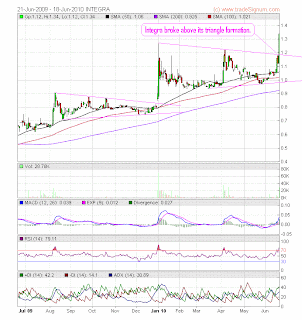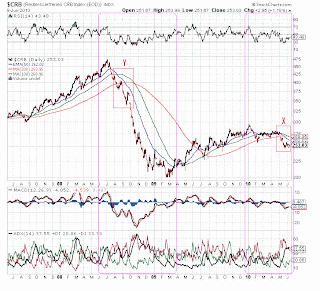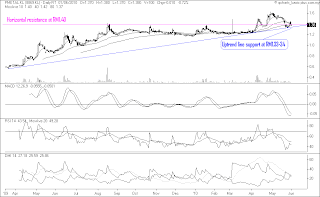Results UpdateGenM has just announced its results for QE31/3/2010 on May 27. Despite a 5%-increase in its turnover (from RM1.28 billion to RM1.35 billion), GenM's net profit dropped by 24% q-o-q (from RM358 million to RM272 million). On the other hand, its net profit dropped by a marginal 1% y-o-y while turnover was up by 14%. The q-o-q drop in GenM's net profit was attributable to impairment loss arising from the investment in Walker Digital Gaming, LLC ('WDG') of RM108 million.
 Table 1: GenM's last 8 quarterly results
Table 1: GenM's last 8 quarterly results Chart 1: GenM's 15 quarterly resultsInvestors' Main Concerns
Chart 1: GenM's 15 quarterly resultsInvestors' Main ConcernsTwo of the main concerns that investors have regarding GenM are:
i) the use of the company's funds for inter-company transactions, such as the acquisition of WDG in 2008; and
ii) the potential drop in GenM's casino business due to the opening of the casino by its sister company, Genting Singapore.
The first concern will persist but the second issue may be put to rest with the announcement of the latest results. I have prepared the charts for the revenue, pre-tax profit & pre-tax profit margin for GenM's Leisure & Hospitality division (which houses the casino operation) from June 2006 until Mar 2010. It is quite clear that despite the start of the Genting Singapore's casino operation in February 2010, the casino operation of GenM did not suffer at all. In fact, we can see that revenue & pre-tax profit have increased (as per Chart 2) & pre-tax profit margin has also inched up (as per Chart 3).
 Chart 2: GenM's Leisure & Hospitality Division's top-line & bottom-line for the past 16 quarters
Chart 2: GenM's Leisure & Hospitality Division's top-line & bottom-line for the past 16 quarters Chart 3: GenM's Leisure & Hospitality Division's pre-tax profit margin for the past 16 quartersValuation
Chart 3: GenM's Leisure & Hospitality Division's pre-tax profit margin for the past 16 quartersValuationAs at 31/3/2010, GenM has cash reserves of RM5.273 billion and it also held AFS totaling RM1.618 billion. These cash-cum-liquid assets are equivalent to RM1.17 per share. If this amount is deducted from its closing price of RM2.80 yesterday, GenM is now trading at a PER of 7 times (based on last 4 quarters' EPS of 23 sen). If we valued GenM at a PER of 15 times & add back the cash-cum-liquid assets of RM1.17 per share, GenM would have a fair value of RM4.62.
Technical OutlookGenM has been moving sideway, between RM2.70 & RM2.90 after "breaking" above its long-term downtrend line ('RR') in November last year. It re-tested that downtrend line last week at RM2.50. With the fear of revenue cannibalization by its sister casino in Singapore disproved, I believe that GenM's may see better prices in the near future.
 Chart 4: GenM's weekly chart as at June 1, 2010 (Source: Quickcharts)Conclusion
Chart 4: GenM's weekly chart as at June 1, 2010 (Source: Quickcharts)ConclusionBased on good financial performance & cheap valuation, GenM is a good stock for long-term investment. However, its technical outlook is still neutral & showing no sign of a move to the upside.












































